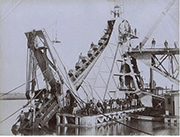E-Archive
Off the Beaten Track
in Vol. 21 - May Issue - Year 2020
From Egypt To Persia

Canal of the Pharaohs

Dredging machine in the 1860s
Attempts to open a water route between the Mediterranean Sea and the Red Sea date back to the ancient Egyptian Pharaonic dynasties. Early efforts concentrated on connecting the Nile River with the Red Sea through west-east canals.
In 1850 BC, the Pharaoh Senusret III built an irrigation channel from the Nile River to two interconnected lakes known as the Great Bitter Lake and the Little Bitter Lake. This channel became navigable during the flooding season of the Nile. It is believed that in that period the Red Sea reached as far north as the Bitter Lakes, meaning that it would have been possible to sail from the Red Sea to the Mediterranean. However, fifteen centuries later the Greek philosopher Aristotle claimed that the Pharaoh stopped work when it was realized that the Red Sea was higher than the Nile, posing the danger of salty seawater entering the Nile riverbed.
In about 1310 BC, the Pharaoh Sity I attempted to resume his predecessor’s work, only to be stymied by rapid silting.
According to the Greek historians Herodotus and Diodorus, in 610 BC the Pharaoh Necho II started work on a bigger, much longer waterway south of the old channel. Herodotus claims that about 100,000 workers died during construction, which was abandoned by Necho II before completion because of a warning from an oracle.
After the Persian conquest of Egypt, Darius the Great took up Necho’s project in 510 BC. He cleared out the silt and completed excavation. According to Herodotus, the new canal was wide enough to allow two triremes (warships with three banks of oars) to pass each other with oars extended. To celebrate his achievement, the Persian king erected several granite steles with the following inscription: “King Darius says: I am a Persian; setting out from Persia I conquered Egypt. I ordered to dig this canal from the river that is called Nile and flows in Egypt, to the sea that begins in Persia. Therefore, when this canal had been dug as I had ordered, ships went from Egypt through this canal to Persia, as I had intended.” This work became known as the “Canal of the Pharaohs” and the granite steles were discovered during archeological digs in the 1800s. However, later ancient Greek and Roman historians such as Aristotle, Strabo and Pliny the Elder claim that Darius could not have completed the canal because of the problem of the difference in height between the Nile and the Red Sea.
According to Strabo and Pliny the Elder, the work was finally completed during the reign of Ptolemy II, after Alexander the Great had conquered the Persian Empire and had acquired all of its territories. In 274 BC, Ptolemy’s engineers solved the problem of the height difference by building double locks that prevented the salty waters of the Red Sea from entering the Nile River. Two centuries later, it had become impossible to clear the huge amounts of silt brought by the Nile and Ptolemy’s canal was abandoned.
It appears that several failed attempts to reopen the waterway were made in the following years, most notably by the Roman Emperor Trajan in the 2nd century AD and by the Arab conqueror Amr ibn al-As al-Sahmi in the 7th century AD. Commerce between East and West resumed by transshipment with camel caravans between Alexandria and ports on the Red Sea. With its powerful merchant and military fleets, the Republic of Venice had a virtual monopoly on this trade.
When the Portuguese explorer Bartolomeu Dias circumnavigated Africa in 1488, a direct maritime trading route to India and the Far East had been opened. Faced with the danger of losing its lucrative business, Venice opened negotiations with Egypt’s rulers to build a direct canal from the Mediterranean to the Red Sea, thereby bypassing the Nile. These plans were interrupted by the Ottoman conquest of Egypt in 1517.
After conquering Egypt in 1798, the French Emperor Napoleon considered the possibility of building a new direct canal, but was dissuaded by his engineers who erroneously claimed that the Red Sea was about ten meters higher than the Mediterranean. This would have required locks, very expensive to build and maintain.
After new studies proved that there was no difference in height between the two seas, in 1854, the Frenchman Ferdinand de Lesseps obtained a concession from the Ottoman Viceroy to create a company to build and operate a new waterway. Work started in April 1859 and the Suez Canal was inaugurated in November 1869.
By Giovanni Gregorat, Contributing Editor MFN




























